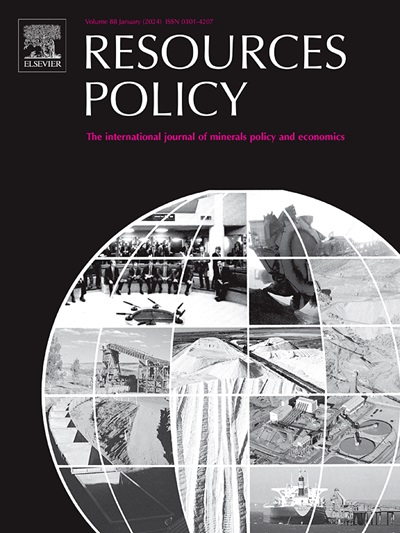Nickel and cobalt from U.S. mines and refineries: Assessment of five dimensions of mineral availability
IF 10.2
2区 经济学
0 ENVIRONMENTAL STUDIES
引用次数: 0
Abstract
Federal policies in the United States (U.S.) are aimed at increasing domestic mining and refining of critical minerals such as nickel (Ni) and cobalt (Co). These two metals are key components in lithium-ion NMC batteries common in electric vehicles. This paper examines active and proposed Ni and Co mining and refining projects in the U.S. to evaluate five dimensions of mineral availability: 1) Geological, 2) Technical, 3) Economic, 4) Political, and 5) Social and Environmental. Only very small amounts of Ni and Co have been mined in the U.S. in recent decades. Despite significant geological resources of Ni and Co in the U.S., the only Ni mining is at Eagle, Michigan, which produces a nickel concentrate that is refined in Canada. There is no U.S. Co production, and recent Co mine construction in Idaho has halted due to market pricing. Proposals for new Ni mines have met with social opposition and regulatory complexity at Maturi, NorthMet, and Mesaba in Minnesota based on environmental concerns. Domestic refining is limited to minor byproduct recovery of Ni and Co from Stillwater ores at the Columbus refinery, Montana. Refineries have been proposed or are under construction in Missouri, Idaho, and Minnesota. Despite the geological availability of U.S. Ni and Co, the majority of these resources have not yet been demonstrated as viable from the technical, economic, political, social and environmental dimensions.
来自美国矿山和精炼厂的镍和钴:矿物可用性的五个维度评估
美国的联邦政策旨在增加国内对镍(Ni)和钴(Co)等关键矿物的开采和精炼。这两种金属是电动汽车中常见的锂离子NMC电池的关键成分。本文考察了美国正在进行的和拟议的镍和钴开采和精炼项目,以评估矿物可用性的五个维度:1)地质,2)技术,3)经济,4)政治,5)社会和环境。近几十年来,美国只开采了非常少量的镍和钴。尽管美国有丰富的镍和钴地质资源,但唯一的镍矿是在密歇根州的伊格尔,它生产的镍精矿在加拿大提炼。美国没有Co生产,最近爱达荷州的Co矿山建设因市场定价而停止。在明尼苏达州的Maturi、NorthMet和Mesaba,基于环境考虑,新镍矿的提议遭到了社会的反对和复杂的监管。国内精炼仅限于在蒙大拿州哥伦布炼油厂从斯蒂尔沃特矿石中回收少量副产品镍和钴。在密苏里州、爱达荷州和明尼苏达州已经提出或正在建设炼油厂。尽管美国的镍和钴在地质上是可用的,但这些资源中的大多数尚未从技术、经济、政治、社会和环境方面被证明是可行的。
本文章由计算机程序翻译,如有差异,请以英文原文为准。
求助全文
约1分钟内获得全文
求助全文
来源期刊

Resources Policy
ENVIRONMENTAL STUDIES-
CiteScore
13.40
自引率
23.50%
发文量
602
审稿时长
69 days
期刊介绍:
Resources Policy is an international journal focused on the economics and policy aspects of mineral and fossil fuel extraction, production, and utilization. It targets individuals in academia, government, and industry. The journal seeks original research submissions analyzing public policy, economics, social science, geography, and finance in the fields of mining, non-fuel minerals, energy minerals, fossil fuels, and metals. Mineral economics topics covered include mineral market analysis, price analysis, project evaluation, mining and sustainable development, mineral resource rents, resource curse, mineral wealth and corruption, mineral taxation and regulation, strategic minerals and their supply, and the impact of mineral development on local communities and indigenous populations. The journal specifically excludes papers with agriculture, forestry, or fisheries as their primary focus.
 求助内容:
求助内容: 应助结果提醒方式:
应助结果提醒方式:


